In Brief
From sponsorship to contextual advertising, the opportunities for brands to get closer to TV content has never been greater. Whether it’s aligning your brand with the perfect programme or going all-out to sponsor an entire channel, the prospects are rife. And the benefits don’t stop at the big screen. The associations created on telly are increasingly being leveraged across a multitude of media and brand touchpoints.
So we know that TV sponsorships work, but where we’re less certain is just how it works and why it works so effectively. How can advertisers optimise the associations to improve their brand health and how do the different facets of TV sponsorship work?
Thinkbox commissioned both House 51 and YouGov to conduct an innovative and ground breaking study, exploring all of the aspects of TV sponsorship from how it works on the brain to how those effects translate into results for different kinds of partnerships.
Key findings
- Programme partnerships drive brand preference. Sponsorship acts as a matchmaker between brand and viewer and allows brand associations to embed more easily in the viewer’s mind
- The stronger the programme relationship, the more positive the viewer is towards the sponsor
- Programme partnerships drive awareness and brand stature, particularly for low-awareness brands
- Fit is everything: a strong fit between the brand, programme, creative and increasingly, creative congruence with other forms of advertising activity, magnifies a sponsorship’s effects
- The associative nature of content partnerships means that longer sponsorships tend to deepen brand health metrics, whereas the short-term partnerships are better at driving awareness
- The effects of sponsorship are relatively long-lived with brand health metrics decaying slowly once partnerships come to an end.
In Depth:
Background
We already know that TV sponsorship works in a different way to spot advertising and that its power comes from its ability to improve brand perception (largely implicitly). By default, humans are not geared to think much about brands – we’re too preoccupied with the important stuff: our friends, family, work and home-life. But we’re also a species that seeks stimulation, and with the stresses of everyday modern life we hugely value our down-time and opportunities to socialise and relax. This is one of the reasons why TV is so valued; it provides an important source of entertainment, information, relaxation and of course a shared point of interest between household members and millions of others throughout the UK. Through partnering with TV programmes, brands can leverage this relationship and become a part of a viewer’s world.
This was the foundation of our thinking when commissioning this research and using Psychology and Behavioural Science we identified three core areas of how we believed programme partnerships drive brand affinity.
1. Love is based on incorporating others into the self
There is a long established psychological theory[i] stating that relationships (in part) are built through creating an overlap between ourselves and others. As we form stronger relationships with others we start to reflect each other in our humour, the language we use (both verbal and body) and in our interests and values.
We also know from academic research[ii] that the same holds true for our relationship with brands. The stronger the overlap between our self-image and our perception of a brand’s image, the stronger relationship we’ll have with that brand.
Our first hypothesis for this research was that programme partnerships are a powerful means to drive a stronger relationship between a viewer and a brand through increasing the brand/self overlap.
2. Our behaviour is driven by the unconscious
Every day we’re bombarded by a barrage of information and need to make thousands of decisions that dictate our day-to-day life. It would be impossible to rationally calculate every decision we have to make.
Brands provide brilliant decision-making shortcuts. Take this, for example:
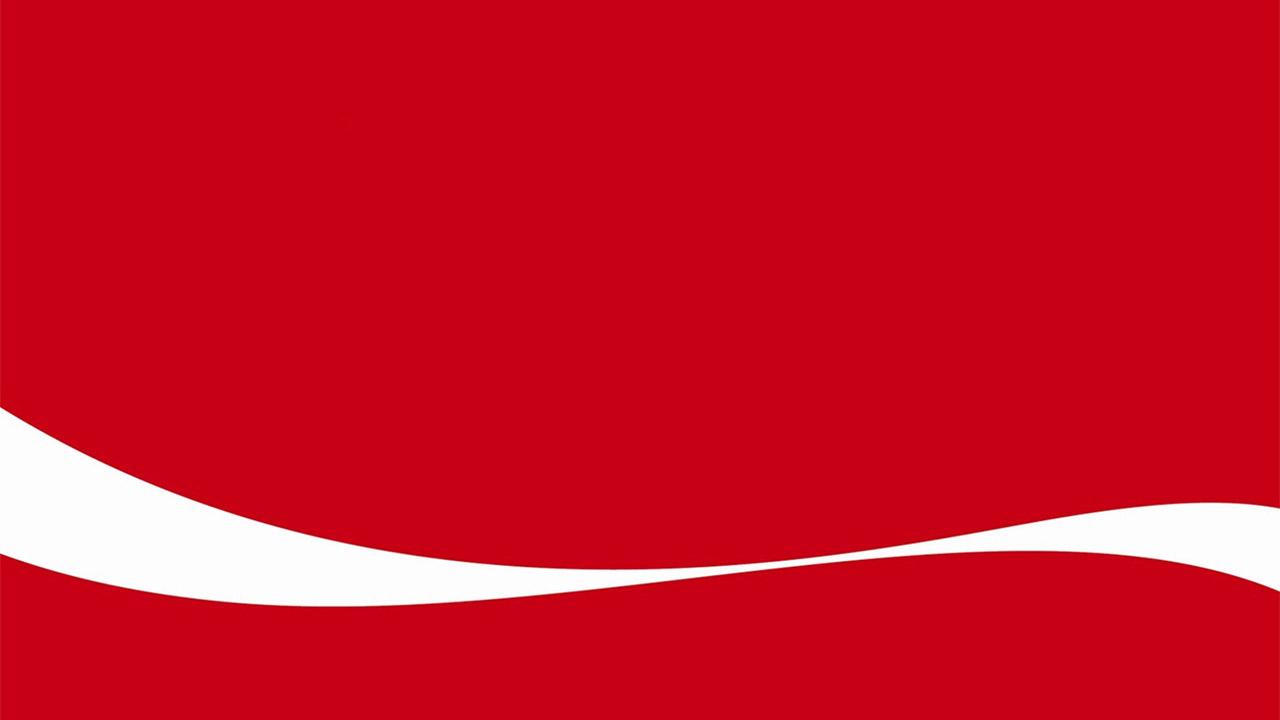
Decades of consistent branding mean that most of us instantly recognise the Coca-Cola logo without having to read the text. The associations have been firmly hard-wired into our brains. We don’t need to think about it, we can just reach for the can and know exactly what we’ll get.
This is where advertising comes in. Everyone familiar with Byron Sharp and the Ehrenberg-Bass institute for marketing science will know about the importance of ‘mental availability’ (alongside physical availability). The more associations we have with a brand and the stronger these associations are, the more likely we are to choose this brand over another within the competitive set.
Our second hypothesis for this research was that programme partnerships can significantly help build mental availability for brands, by increasing and strengthening positive associations.
3.Our behaviour is driven by costly signalling
Driven by our innate need to short-cut, we’re constantly seeking sub-conscious reassurance that the decisions we make are worthy. The fact that advertisers are willing to invest in their brands through advertising is almost as important as the messages themselves.
Take, the not-so-humble peacock, for example.
The peacock drove Darwin mad as he couldn’t identify the purpose of its plumage. But that was exactly the point. The peacock has such a pointless appendage just because it can. Precisely, because it can afford it!
Advertising plays a similar role. It’s a costly signal that shows an advertiser is high quality and so worthy of our time, attention and investment.
Our third hypothesis was that programme partnerships act as a ‘costly signal’ and help to establish the high quality / popularity of a brand.
Methodology
We commissioned a far-reaching and detailed study into both the mechanics and effects of TV sponsorship:
Part 1: Testing our hypotheses on the mechanics of programme partnership.
Working with House 51, we sought to understand how TV sponsorship works - both on an implicit and explicit level – and to deconstruct the impact sponsorship has between viewers, non-viewers and fans of sponsored programmes. We did this through a combination of 12 mobile self-ethnographies and six filmed depth-interviews. In addition, we ran a quantitative survey for eight different programme partnerships, each time surveying 150 viewers & 150 non-viewers, using a series of both implicit and explicit methods.
Part 2: Providing robust evidence for the impact of programme partnerships on brand health and the drivers of increased effectiveness.
In a research first, YouGov combined their Brand Index data (covering 1,200 brands and 4,000 interviews per day) with their TV viewing data (4,000 interviews per day) to assess how different types of programme partnership (36 in total) affect the various elements of brand health for the sponsors. The impact was assessed for both viewers (those that had viewed the sponsored programme at least once during the period of the partnership or at least once a year for long running partnerships) versus non-viewers. All cells were demographically matched to the target audience of the sponsorship.
Brand health was measured in relation to brand performance:
- Impression (positivity/negativity towards brand)
- Reputation (proud/embarrassed to work for company)
- Quality (brand represents good/poor quality)
- Consideration (propensity to consider purchase)
The ‘Partnership Index’ referenced throughout was an average across each of the above.
Findings
Part 1: How did the results stack up against our hypotheses?
Hypothesis 1) Programme partnerships are a powerful means to drive a stronger relationship between a viewer and a brand through increasing the brand/self overlap.
Across all eight studies we found that viewers of the sponsored programmes had much higher brand preference than non-viewers.
Using Foster’s sponsorship of original comedy across the C4 network as an example, we can see the huge impact the partnership has on boosting brand attributes. (See figure 1).
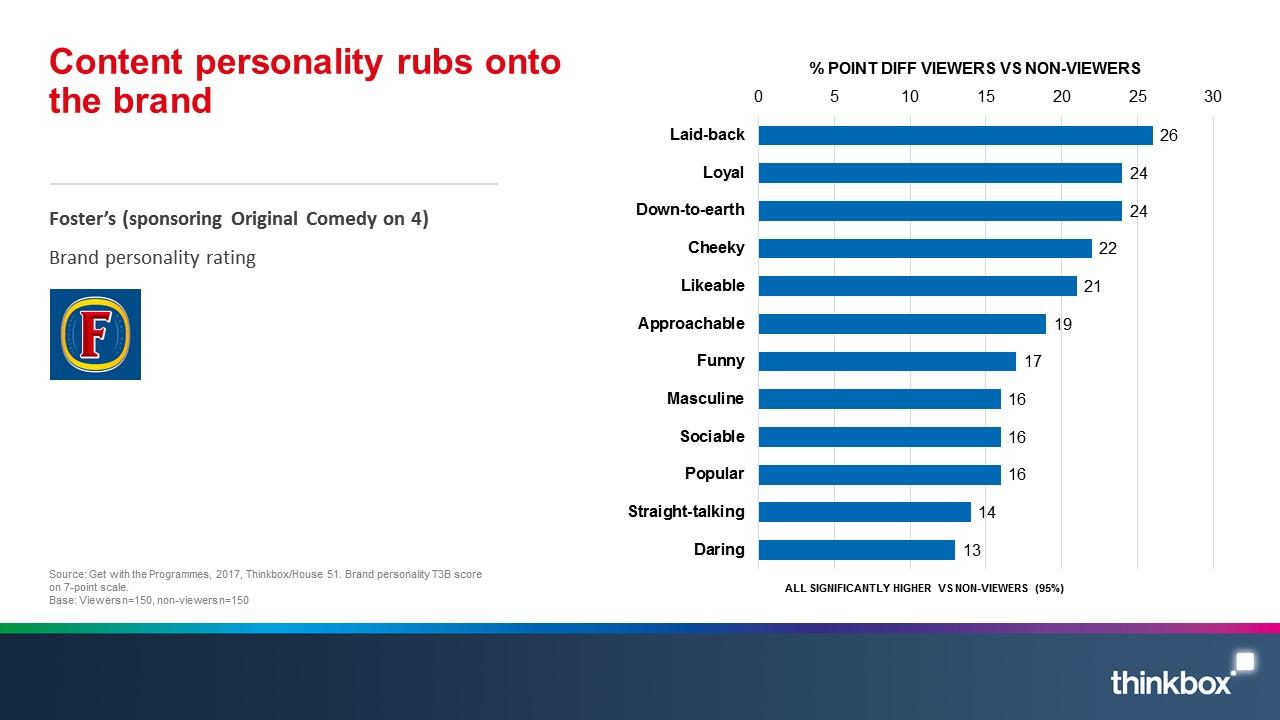
When comparing the brand personality to the personality score of the respondent, we found that among viewers, their perception of the brand was much more likely to be in line with their perception of themselves, i.e. there was a high degree of brand/self overlap. (See figure 2).
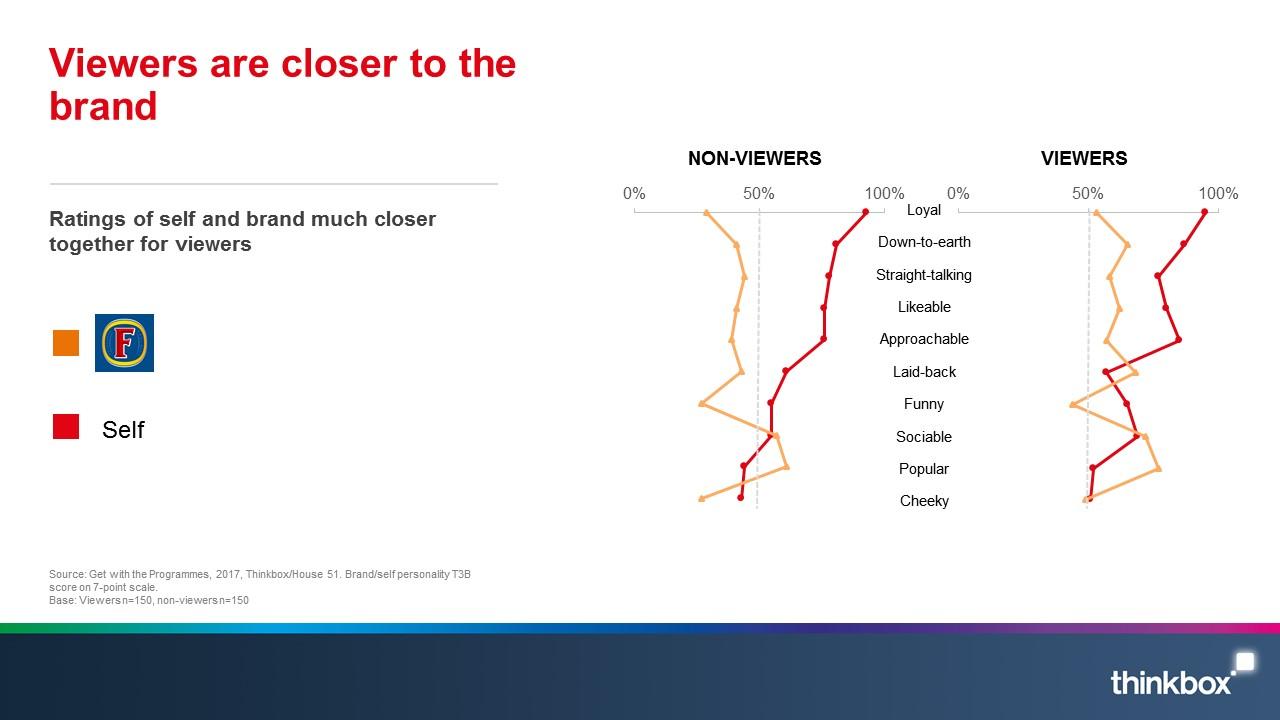
This is evidence that programme partnerships enable brands to borrow the attributes of the programme they’re sponsoring and in so doing form a stronger relationship with the viewer through an increase in shared brand attributes.
On average, across all eight brands, the personality fit between a viewer and a sponsoring brand was 50% higher than the fit between a sponsoring brand and a non-viewer.
In addition, we found a strong relationship between increased congruency between self and brand and higher consideration. For example, the more a brand’s personality fits with our own personality, the more likely we are to consider purchasing it. (See figure 3).
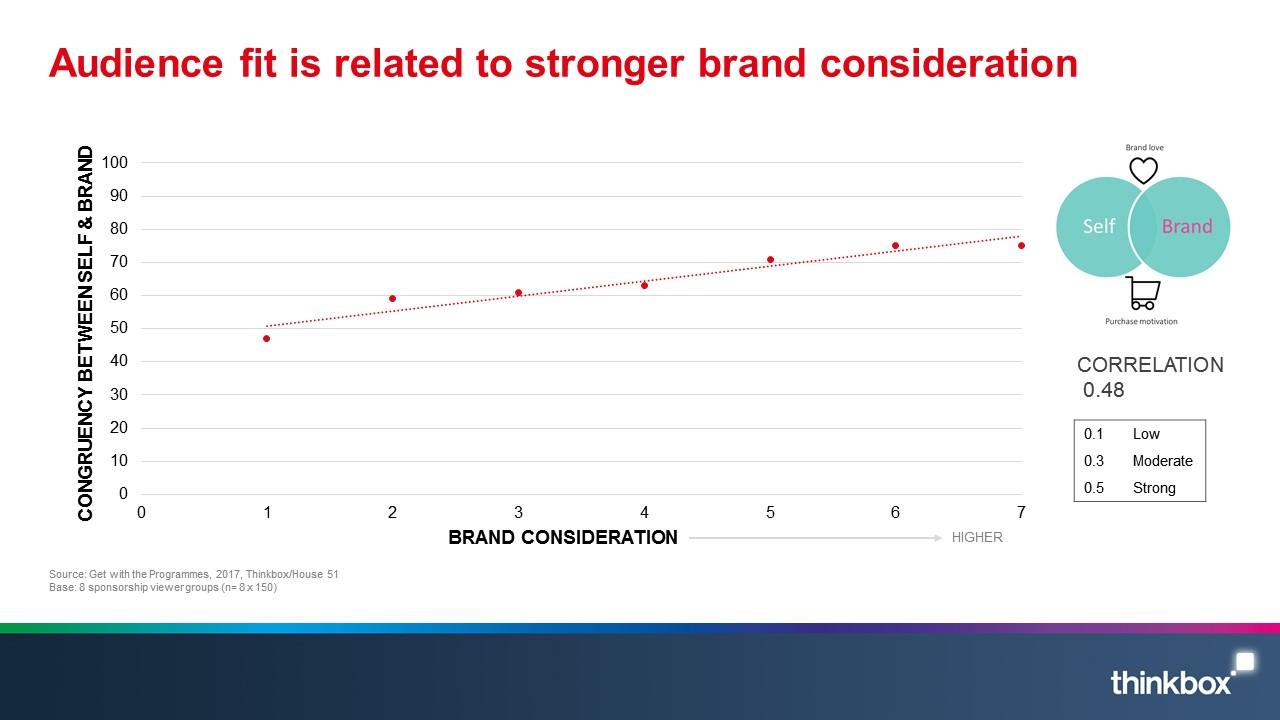
Hypothesis 2) Programme partnerships can significantly help to build mental availability for brands, by increasing and strengthening positive associations.
Whilst sponsorship bumpers are more tightly regulated in terms of messaging than spot advertising, there’s a huge amount that they’re able to communicate.
Programme partnerships help build mental availability for brands by increasing the number of positive associations. There are many ways this can be done. Creating a strong fit with the programme through the sponsorship creative is arguably the most important. However, we also found that developing a strong creative fit with a brand’s other advertising is also beneficial, as is capitalising on the viewer need state surrounding the property being sponsored (e.g. shared family viewing time). (See figure 4).
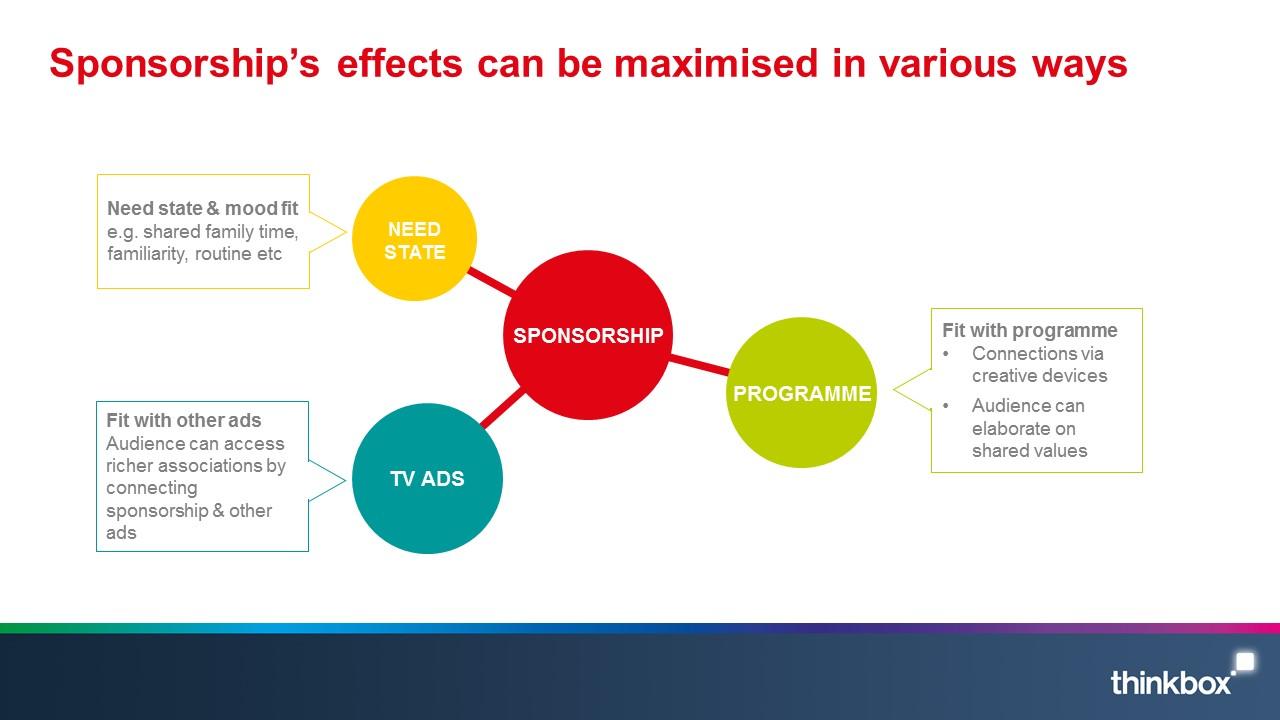
The effects of increased mental availability manifest in our subconscious and as such are easiest to detect using implicit techniques.
Figure 5 shows that on average across eight partnerships tested viewers are both more likely to agree with positive brand statements and are also likely to agree much faster than non-viewers. This shows that programme partnerships are working at an implicit level and driving automatic, positive brand associations.
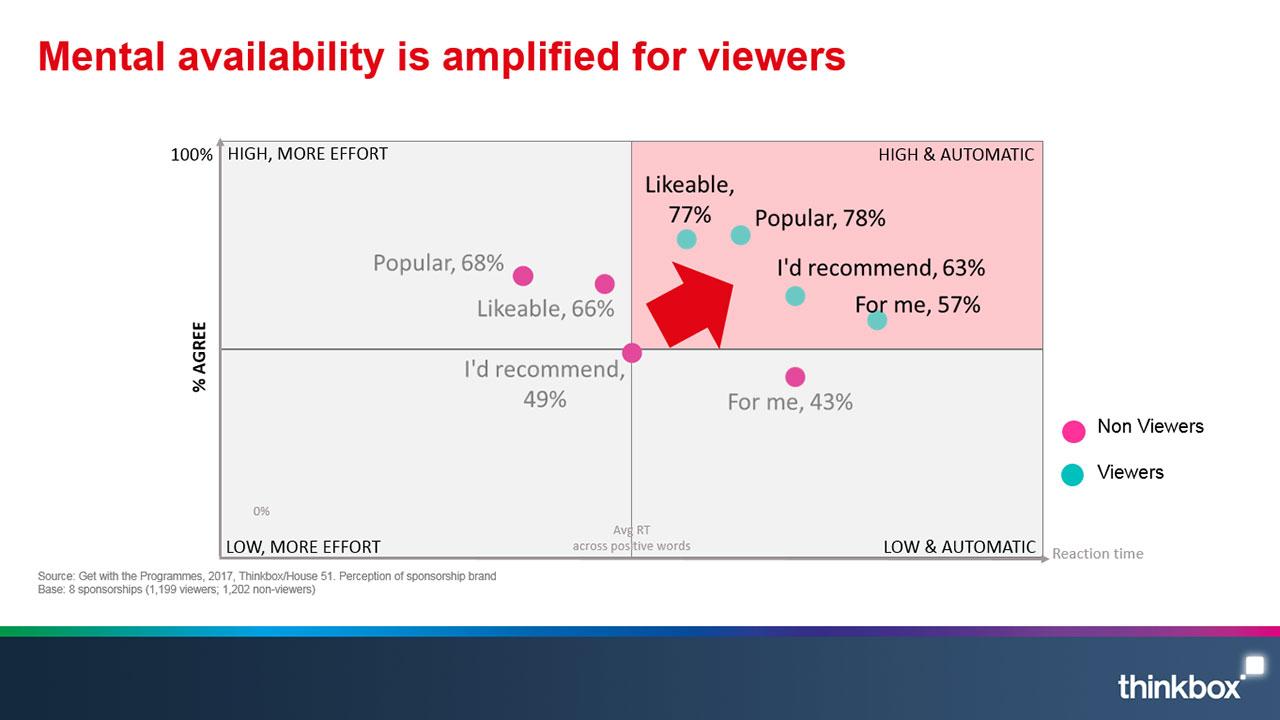
Hypothesis 3) Programme partnerships act as a ‘costly signal’ and help to establish the high quality / popularity of a brand.
House 51 quantified the Peacock Effect by showing programme viewers were more likely to identify the sponsoring brands as being popular; sponsorship has the ability to make brands famous and more top-of-mind. (See figure 6).
Part 2: YouGov: Evidence for the impact of programme partnerships on brand health and the drivers of increased effectiveness
Creating benchmarks
YouGov’s data provides us with benchmarks on the effect of different types of programme partnerships on key measures of brand health. As the definition of a ‘viewer’ is the bare minimum requirement (a respondent has had to watch the programme at least once to be classified as a viewer), these findings show a much lower effect on brand health than studies that are based on regular viewers or fans of programmes. As this methodology is analogous to programme reach it can therefore be easily applied to BARB reach data for series and strands. For example, if the average uplift is a 5% increase in brand reputation and the programme reaches 10 million people, then typically this show will drive a 5% increase in reputation among that group of 10 million viewers. Clearly there will be light and shade of effect among this group dependent on their weight of viewing.
Programme partnerships drive awareness, particularly for low-awareness brands
For most established advertisers, prompted awareness is a tough metric to shift once you’ve hit the 90% + ceiling. However, if your brand is middling to low in terms of prompted awareness, programme partnerships can have a powerful effect on driving brand health upwards.
YouGov split out the brands in the survey that had the highest awareness from those at the lower end of the scale – and the results were impressive. Both brand and ad awareness for the lower awareness brands was substantially higher for programme viewers. (And that’s in addition to the other enhanced brand health metrics. See figure 7).
When you consider that the ‘lower awareness’ brands in Brand Index are still relatively well-known due to the very nature of the methodology, you understand the huge potential that TV sponsorship would offer to newer brands.
Frequency dials up brand effects
Given that sponsorship works via association and associations take time to embed in the mind of the viewer, it makes sense that higher frequency campaigns are the most effective at driving brand health effects.
We calculated frequency by taking the average monthly TVRs for individuals for each sponsorship and divided this by the monthly reach. This gave a relative measure of frequency for each partnership. Those that fell within the bottom third of the dataset were classed as low frequency and the top third were categorised as high frequency.
Both high and low frequency campaigns delivered good increases in brand health, but the higher frequency ones worked slightly harder, particularly in terms of driving brand reputation and impression. Unsurprisingly, ad awareness was also positively impacted by high awareness sponsorships. (See figure 8).
Making the most of content partnerships
As with everything in life, the more you put in, the more you get out and the same applies to content partnerships.
Fit is everything
House 51 and YouGov discovered that fit is one of the most important factors in any TV sponsorship – fit between the audience, programme, brand and creative.
In our 2008 sponsorship research, ‘Sponsorship: a brand’s best friend’, it became apparent that creative treatment was integral to utilising any TV partnership and as long as the creative link was strong enough, pretty much any programme property could be linked to any brand.
This was confirmed by YouGov who found that creatively congruent campaigns were much more effective at shifting the brand health metrics for viewers than campaigns where the creative fit was less obvious. (See figure 9).
But both YouGov and House 51 took this finding a step further. They demonstrated that it’s not just the fit with the programme, but the integration between the sponsorship idents and other forms of advertising that was a key driver of a brand’s success. Campaign integration significantly shifted the brand health metrics for viewers (see figure 10).
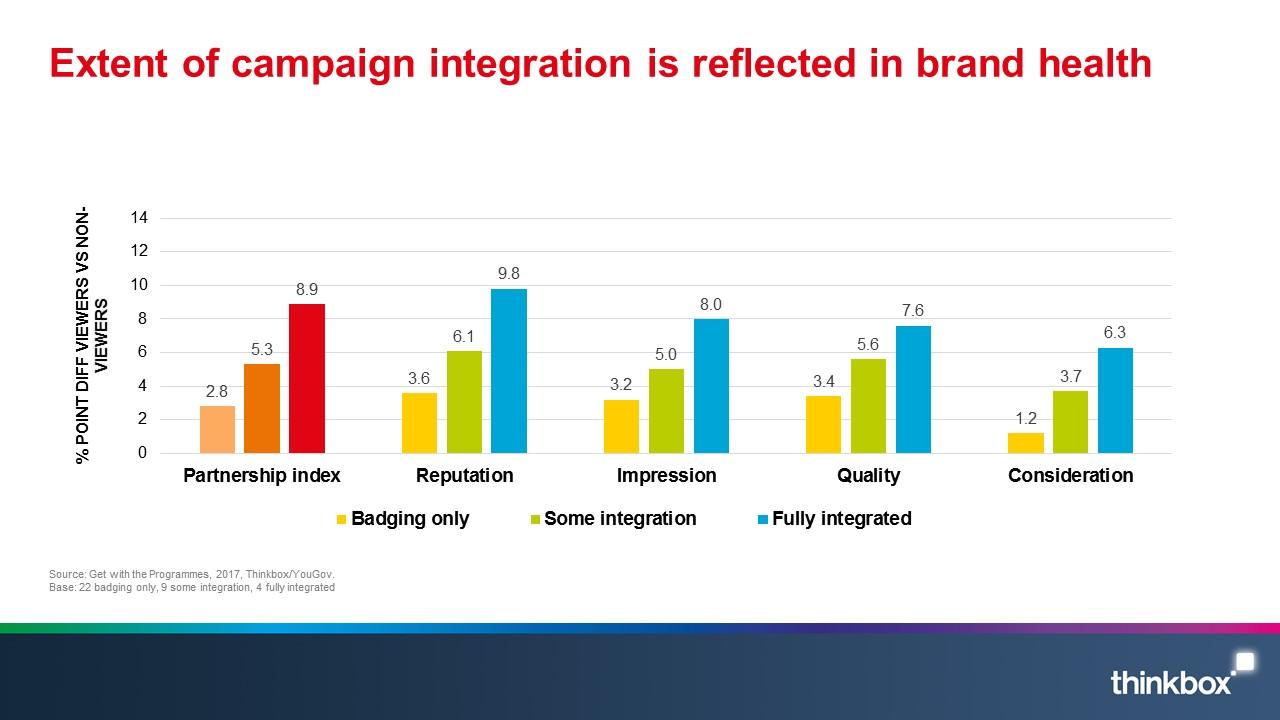
This was echoed by House 51 who found the stronger the perceived link between the idents and other forms of advertising, the higher the level of brand consideration. This was true of every sponsorship analysed.
Where possible, play the long-game
Given that sponsorship works by facilitating, nurturing and embedding a relationship between programme and brand within the mind of a viewer, it makes sense that this takes time.
YouGov split the campaigns that had been on air for over three years versus those that had been running for less than 12 months. The longer running campaigns drove increases in all brand health metrics over and above the younger campaigns, with the most significant gains seen against reputation and consideration. (See figure 11). By their very nature, these metrics are deeply entrenched and therefore some of the most difficult to shift, so a long-term sponsorship approach is an incredibly effective way of gaining traction in these areas.
Conversely, short-term campaigns are better at improving both ad and brand awareness.
It’s not over when it’s over
Of course, all good thing must come to an end, but the effects of sponsorship can be relatively long-lived. YouGov gathered results for all completed sponsorships to understand what happened in the nine months following the campaign’s end. Whilst ad awareness fell quickly, the brand health metrics decayed at a far slower rate. (See figure 12).
This highlights the associative nature of content partnerships. It’s all about familiarity and strong connections and these are elements that grow over time and lie deeply rooted in the brain.
In summary
Although there is no ‘one-size fits all’ approach to content partnerships, there are a barrage of opportunities for advertisers to tap into TV content in a variety of different ways. Whether it’s matching messages to TV moods or moments (i.e. tapping into our need for pizza by sponsoring Saturday night TV) or improving brand health through positive association, the opportunities are boundless. By harnessing the power of association, advertisers can tailor their activity to reap the rewards; be that incresed brand efficacy, awareness or consideration. There has never been a more compelling time to get with the programmes.
[i] The Principles of psychology – Willam James.[ii] Joseph Sirgy (1985): Using self-congruity and ideal congruity to predict purchase motivation. Journal of Business Research (13):195-206
 Thinkbox
Thinkbox